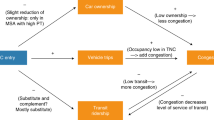Abstract
Road socialists maintain that government is the best manager for the nation's vehicular transportation arteries. Contrary to their views, the present author maintains that the managerial role can best be fulfilled by private entrepreneurs. Under highway privatization, he claims, traffic fatalities and automobile congestion will be sharply reduced.
Similar content being viewed by others
References
AschP. and D. T.Levy (1987). ‘Does the minimum drinking age affect traffic fatalities?’ Journal of Policy Analysis and Management 6 Winter, 180–192.
BlockW. (1983a). ‘Public goods and externalities: The case of roads.’ The Journal of Libertarian Studies VII (1) Spring, 1–34.
BlockW. (1983b). ‘Theories of highway safety.’ Transportation Research Record 912, 7–10.
BlockW. (1980). ‘Congestion and road pricing.’ The Journal of Libertarian Studies IV (3) Fall, 299–330.
BlockW. (1979). ‘Free market transportation: Denationalizing the roads.’ Journal of Libertarian Studies III (2) Summer, 209–238.
BuchananJ. M. (1979). ‘Public choice and public finance.‘ In What Should Economists Do? Indianapolis: Liberty Press.
BuchananJ. M. (1990). ‘The contractarian logic of classical liberalism’. In Ellen FrankelPaul and HowardDickman (Eds.), Liberty, Property, and the Future of Constitutional Development, Albany: State University of New York Press.
BuchananJ. M. (1975). The Limits of Liberty. Chicago: University of Chicago Press.
BuchananJ. M., R. D.Tollison, and G.Tullock (Eds.) (1980). Toward a Theory of the Rent-Seeking Society, College Station: Texam A&M University.
BuchananJ. M. (1964). ‘What should economists do?’ The Southern Economic Journal 30 (3), 213–222.
BuchananJ. M. and G.Tullock (1971). The Calculus of Consent: Logical Foundations of Constitutional Democracy, Ann Arbor: University of Michigan.
Buxbaum, R. G. and T. Colton (1966). ‘Relationship of motor vehicle inspection to accident mortality.’ The Journal of the American Medical Association, 101–106.
Callahan, J. M. (1970). ‘States move slowly on safety projects.’ Traffic Digest and Review March, 7–12.
CastleG. (1976). ‘The 55 mph speed limit: A cost-benefit analysis.’ Traffic Engineering 45 January, 11–14.
CirilloJ. A. (1968). ‘Interstate system accident research study II, interim report II.’ Public Roads 35 August, 71–75.
CookP. J. and G.Tauchen (1984). ‘The effect of minimum drinking age legislation on youthful auto fatalities, 1970–1977.’ Journal of Legal Studies XIII, 169–190.
CrainM. W. (1980). Vehicle Safety Inspection Systems. Washington D.C.: American Enterprise Institute for Public Policy Research.
CrandallR. W., H. K.Gruenspecht, T. E.Keeler, and L. B.Lave (1986). Regulating the Automobile, Washington D.C.: The Brookings Institution.
DudaJ. L. (1977). Program Evaluation Support for the Motor Vehicle Diagnostic Inspection Demonstration Projects, Vol. II: Costs and Benefits. Falls Church, VA: Computer Sciences Corporation.
EgmoseL. and T.Egmose (1986). ‘Speed limits save lives.’ Journal of Traffic Medicine 14, 4–5.
FaiginB. M. (1976). 175 Societal Costs of Motor Vehicle Accidents. U.s. Department of Transportation, National Highway Traffic Safety Administration, Washington, D.C.
ForesterT., R. F.McNown, and L. D.Singell (1984). A cost benefit analysis of the 55 mph speed limit.’ Southern Economic Journal 50 January, 631–641.
FowlesR. and P. D.Loeb (1989). ‘Speeding, coordination and the 55-mph limit: Comment.’ American Economic Review 79 (4) September, 916–921.
FuchsV. R. and I.Leveson (1967). ‘Motor accident mortality and compulsory inspection of vehicles.’ Journal of the American Medical Association 201 August, 87–91.
GarberN. J. and R.Gadirau (1988). ‘Speed variance and its influence on accidents.’ unpublished manuscript, AAA Foundation for Traffic Safety, Washington D.C.
Grampp, W. S. (1950). ‘Some effects of rent control.’ Southern Economic Journal April, 425–426.
GravesP. E., P. E.Lee, and R. L.Sexton (1989). ‘Statutes versus enforcement; the case of the optimal speed limit.’ American Economic Review 79 (4) September, 932–936.
GundersonG. (1989). ‘Privatization and the 19th-century turnpike.’ Cato Journal 9 (1) Spring/Summer, 191–200.
HauerE. (1971). ‘Accidents, overtaking, and speed control.’ Accident Analysis and Prevention 3 January, 1–12.
HoppeH.-H. (1993). The Economics and Ethics of Private Property: Studies in Political Economy and Philosophy. Boston: Kluwer.
Hoppe H.-H. (1989). A Theory of Socialism and Capitalism: Economics, Politics and Ethics. Boston: Dordrecht.
HoskinA. (1986). ‘Consequences of raising the speed limit.’ Journal of Safety Research 17, 179–182.
HeyneP. (1991). The Economic Way of Thinking. Sixth edition, New York: Macmillan.
JackmanW. T. (1916). The Development of Transportation in Modern England. Cambridge: Cambridge University Press.
JondrowJ., M.Bowes, and R.Levy (1983). ‘The optimal speed limit.’ Economic Inquiry 21 July, 325–336.
KamerudD. B. (1983). ‘The 55 mph speed limit: Costs, benefits and implied tradeoffs.’ Transportation Research 17A January, 51–64.
Klein, D. (1990). ‘The voluntary provision of public goods? The turnpike companies of early America.’ Economic Inquiry October, 788–812.
Klein, D., J. Majewski, and C. Baer (1993a). ‘Economy, community and the law: The turnpike movement in New York, 1797–1845.’ The Journal of Economic History March, 106–122.
Klein, D., J. Majewski, and C. Baer (1993b). ‘From trunk to branch: Toll roads in New York, 1800–1860.’ Essays in Economic and Business History, 191–209.
Klein, D. and G. J. Fielding (1992). ‘Private toll roads: Learning from the nineteenth century.’ Transportation Quarterly July, 321–341.
Klein, D. and G. J. Fielding (1993a). ‘How to franchise highways.’ Journal of Transport Economics and Policy May, 113–130.
Klein, D. and G. J. Fielding (1993b). ‘High occupancy/toll lanes: Phasing in congestion pricing a lane at a time.’ Policy Study 170 November, REason Foundation.
LaveL. B. and W. E.Weber (1970). ‘A benefit cost analysis of auto safety features.’ Applied Economics 2, 265–275.
LaveC. A. (1985). ‘Speeding, coordination and the 55-mph limit.’ American Economic Review 75 (5) September, 1159–1164.
LaveC. (1989). ‘Speeding, coordination and the 55-mph limit: Reply.’ American Economic Review 79 (4) September, 927–931.
LevyD. T. and P.Asch (1989). ‘Speeding, coordination and the 55-mph limit: Comment.’ American Economic Review 79 (4) September, 913–915.
LoebP. D. (1985). ‘The efficacy and cost effectiveness of motor vehicle inspection using cross-sectional data — An econometric analysis. Southern Economic Jurnal 52 October, 500–509.
LoebP. D. (1987). ‘The determinants of motor vehicle accidents with special consideration to policy variables.’ Journal of Transport Economics and Policy 21 September, 279–287.
LoebP. D. (1988). ‘The determinants of motor vehicle accidents — A specification error analysis.’ Logistics and Transportation Review 24 March, 33–48.
LoebP. D. and B.Gilad (1984). ‘The efficacy and cost effectiveness of vehicle inspection — A state specific analysis using time series data.’ Journal of Transport Economics and Policy 18 May, 145–164.
MisesL.von (1969). Bureaucracy. New Rochelle, N.Y.: Arlington House.
PeltzmanS. (1975). ‘The effects of automobile safety regulation.’ Journal of Political Economy 83 (4), 677–725.
RothG. (1987). The Private Provision of Public Services in Developing Countries. Oxford: Oxford University Press.
RothG. (1967). Paying for Roads: The Economics of Traffic Congestion. Middlesex, England: Penguin.
RothG. (1966). A Self-Financing Road System. London, England: The Institute of Economic Affairs.
RothbardM. N. (1973). For a New Liberty. New York: Macmillan.
SchellingT. C. (1978). Micromotives and Macrobehavior. New York: Norton.
SnyderD. (1989). ‘Speeding, coordination and the 55-mph limit: Comment.’ American Economic Review 79 (4) September, 922–925.
Solomon, D. (1964). ‘Accidents on main rural highways related to speed, driver and vehicle.’ Federal Highway Administration, U.S. Department of Transportation, July.
SommersP. M. (1985). ‘Drinking age and the 55-mph speed limit.’ Atlantic Economic Journal 13 March, 43–48.
WilliamsA. F., R. F.Rich, P. L.Zador, and L. S.Robertson (1975). ‘The minimum drinking age and fatal motor vehicle crashes.’ Journal of Legal Studies 4, 219.
WilliamsA. F., P. L.Zador, S. S.Harris, and R. S.Karpf (1983). ‘The effect of raising the minimum drinking age on involvement in fatal crashes.’ Journal of Legal Studies 12, 169.
WoolridgeW. C. (1970). Uncle Sam the Monopoly Man. New Rochelle, N.Y.: Arlington House.
Author information
Authors and Affiliations
Additional information
The author wishes to thank the North American Editor of Transport Policy, and an anonymous referee from the present journal, for helpful suggestions and commentary on an earlier draft of this paper.
Rights and permissions
About this article
Cite this article
Block, W. Road socialism. Int J Value-Based Manage 9, 195–207 (1996). https://doi.org/10.1007/BF00440154
Issue Date:
DOI: https://doi.org/10.1007/BF00440154




